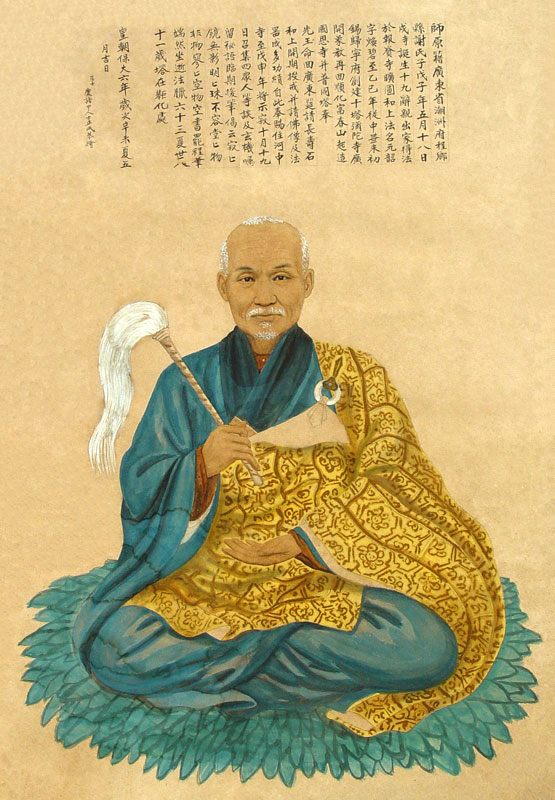ZEN MESTEREK ZEN MASTERS
« Zen főoldal
« vissza a Terebess Online nyitólapjára

Nguyên Thiều 元韶 (1648-1728), aka Siêu Bạch, Hoán Bích
Zen Master Nguyên Thiều
(1648-1728)
http://thuvienhoasen.org/p53a10508/chapter-v-thien-su-viet-nam-vietnamese-zen-masters-51-100
A Chinese Zen Master from Kuang-Tung. He was born in 1648, left home at the age of nineteen and became a disciple of Zen Master Bổn Khao Khoáng Viên at Báo Tư temple in Kuang-T’ung, China. He was the Dharma heir of the thirty-third generation of the Linn-Chih Zen Sect. In 1665, he went to Cental Vietnam and stayed in Qui Ninh, Bình Định, where he established Thập Tháp Di Đà Temple. The temple is situated on Long Bích hill, about 25 kilometers from Qui Nhơn City, across Đập Đá town, in Vạn Xuân hamlet, Nhơn Thành village, An Nhơn district. Later, he went to Thuận Hóa to build Hà Trung Temple, then to Phú Xuân to build Quốc Ân Temple and Phổ Đồng Stupa. At one time, he obeyed order from Lord Nguyễn Phước Thái to return to Kuang-Chou to invite more high-rank Chinese monks to Vietnam, and to obtain more statues of Buddhas as well as religious ritual instruments in preparation for a great Vinaya-affirming ceremony at Thiên Mụ temple. Later on he received an edict to be headmonk of Hà Trung temple. At the end of his life, he moved to Quốc Ân temple. In 1728, after being slightly ill, he summoned all his disciples and delivered a discourse on the wonderful truths of Buddhism. After giving his instructions to the disciples, he wrote his last poem:
The image in the mirror,
The latter tranquil in itself,
Should not be considered as real.
The reflection from a gem,
The latter perfectly clear in itself,
Should not be taken as true.
Things existing to you do not really exist.
What is non-existent to you is truly non- Existent.
Having finished this poem, he peacefully breathed his last breath, at the age of 81. His disciples built a stupa in his memory at Thuận Hóa hamlet, Dương Xuân Thượng village. Lord Nguyễn Phước Châu himself wrote the eulogy for his tomb, and honored him with postthumous title “Hạnh Đoan Thiền Sư.” The stele now remains in front of Quốc Ân temple.
Quoc An Pagoda
http://dulichdanang.vn/en/ancient-monuments-remained-in-hue.html
Zen master Nguyen Thieu Hoan Bich (1648-1729), who was originally from Chaozhou, Guangdong, China. In 1665, he came to Vietnam to expound the dharma and stayed at Qui Ninh mansion (now is Binh Dinh province) and founded Thap Thap-Di Da Pagoda.
In 1683-1684, he travelled to Hue and established Vinh An Pagoda (currently known as Quoc An Pagoda) in the foot of Hoa Thien hill on the left side of Ngu Binh Mountain, Truong An ward during the the reign of Lord Nguyen Phuoc Tan (1648-1687)
With master Nguyen Thieu's tremendous influence, Quoc An Pagoda has been the most prestige Patriarch pagoda and held an important historical role to Buddhism in Dang Trong at that time.
http://vi.wikipedia.org/wiki/Nguy%C3%AAn_Thi%E1%BB%81u
http://www.buddhismtoday.com/viet/pgvn/chua/002-danhlamnuocviet2.htm
http://bodephatquoc.com/chua-thap-thap-di-da-cac-vi-danh-tang-tru-tri-va-hoc-dao.htmlhttp://www.quangminh.org.au/index.php?option=com_content&view=article&id=1056:thin-tong-zen&catid=94:tim-hiu-pht-giao&Itemid=60
http://rongmotamhon.net/mainpage/tracuu_1595_8.html
http://nttvblog.blogspot.hu/2012/01/overview-of-vietnamese-zen.html
PDF: Buddhism and Zen in Vietnam
by Dr. Thich Thien-An, 1975, Charles E. Tuttle Co., Rutland, VT USA and Tokyo, Japan.
Kindle Edition. 2013-04-09.
Chapter 6. Nguyên-Thiều Zen School: A Sect of Lin-chi Tradition Contemporary with Japanese Obaku Zen